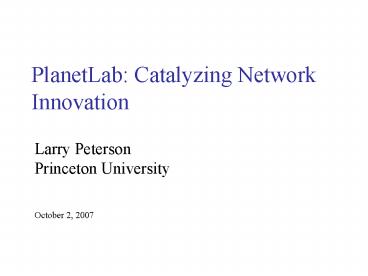PlanetLab: Catalyzing Network Innovation - PowerPoint PPT Presentation
1 / 25
Title:
PlanetLab: Catalyzing Network Innovation
Description:
http://coblitz.org/www.princeton.edu/podcast.mp4. Client. Exploit Layer 2 Circuits ... There is currently a high barrier-to-entry for innovating 'throughout the net' ... – PowerPoint PPT presentation
Number of Views:19
Avg rating:3.0/5.0
Title: PlanetLab: Catalyzing Network Innovation
1
PlanetLab Catalyzing Network Innovation
Larry PetersonPrinceton University
October 2, 2007
2
Challenges
- Security
- weak notions of identity that are easy to spoof
- protocols that rely on good behavior
- Mobility
- hierarchical addressing closely tied with routing
- presumption that communicating hosts are
connected - Availability
- poor visibility into underlying shared risks
- multiple interconnected protocols and systems
- Managability
- many coupled, decentralized control loops
3
Approaches
- Revisiting definition placement of function
- naming, addressing, and location
- routing, forwarding, and addressing
- management, control, and data planes
- end hosts, routers, and operators
- Designing with new constraints in mind
- selfish and adversarial participants
- mobile hosts and disconnected operation
- large number of small, low-power devices
- ease of network management
4
Validation Gap
5
PlanetLab
- 800 machines spanning 400 sites and 40
countries - Supports distributed virtualization
- each of 600 network services running in
their own slice
6
Slices
7
Slices
8
Slices
9
User Opt-in
Client
Server
http//coblitz.org/www.princeton.edu/podcast.mp4
10
Exploit Layer 2 Circuits
Deployed in NLR Internet2 (aka VINI)
11
Circuits (cont)
Supports arbitrary virtual topologies
12
Circuits (cont)
Exposes (can inject) network failures
13
Circuits (cont)
Participate in Internet routing
14
Usage Stats
- Users 2500
- Slices 600
- Long-running services 20
- content distribution, scalable large file
transfer, - multicast, pub-sub, routing overlays, anycast,
- Bytes-per-day 4 TB
- 1Gbps peak rates not uncommon
- Unique IP-addrs-per-day 1M
15
Validation Gap
16
Deployment Gap
Commercial Adoption
Pilot Demonstration (PL Gold)
Ideas
Maturity
Deployment Study (PlanetLab)
Controlled Experiment (EmuLab)
Analysis (MatLab)
Time
17
Case Study Content Distribution
Scalable Algorithms (Simulation)
60-91 better throughput
18
PlanetLab Two Perspectives
- Useful research platform
- Prototype of a new network architecture
19
Network Substrate
Today
Ask substrate for a bit pipe from point A to
point B application logic runs at the edges
Applications
Substrate
20
Network Substrate
Tomorrow
Ask substrate for a logical network of some
topology application logic embedded throughout
Applications
Substrate
21
Lessons Learned
- Trust relationships
- owners, operators, developers
- Virtualization
- scalability is critical
- control plane and node OS are orthogonal
- least privilege in support of management
functionality - Decentralized control
- owner autonomy
- delegation
- federation
- Resource allocation
- decouple slice creation and resource allocation
- best effort overload protection
22
Lesson (cont)
- Evolve based on experience
- support users quickly
- let experience dictate what problems to solve
- Operations
- PlanetLab We debug your network
- From universal connectivity to gated communities
- If you dont talk to your universitys general
counsel, you arent doing network research
23
Remaining Challenges
- Virtualization
- Virtual Machines x Virtual Networks
- Topology Management
- Performance
- NetFPGA (Nick McKeown _at_ Stanford)
- Blade Server NPs (Jon Turner _at_ WashU)
24
Conclusions
- Innovation can come from anywhere
- Much of the Internets success can be traced to
its support for innovation at the edges - There is currently a high barrier-to-entry for
innovating throughout the net - One answer is a network substrate that supports
on demand, customizable networks - enables research
- supports continual innovation and evolution
25
More Information
- www.planet-lab.org
- codeen.cs.princeton.edu/coblitz































